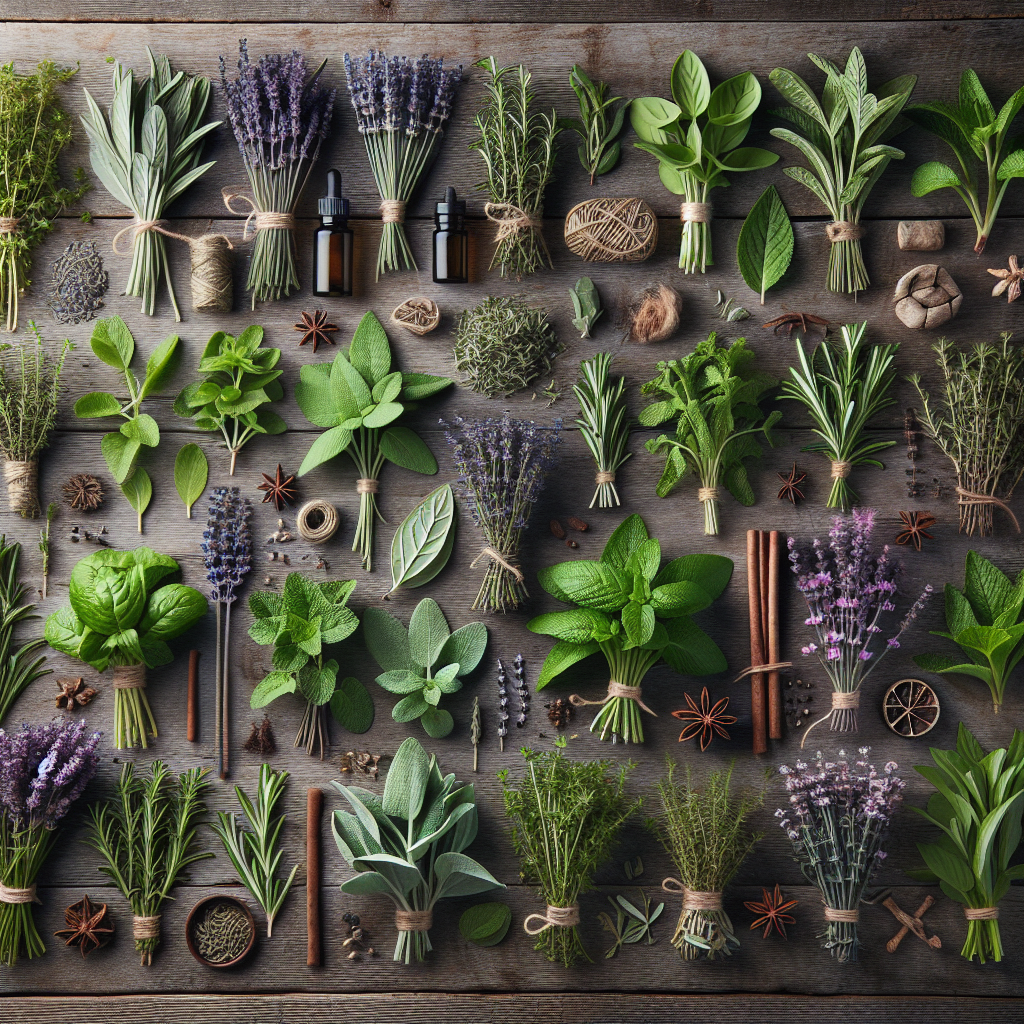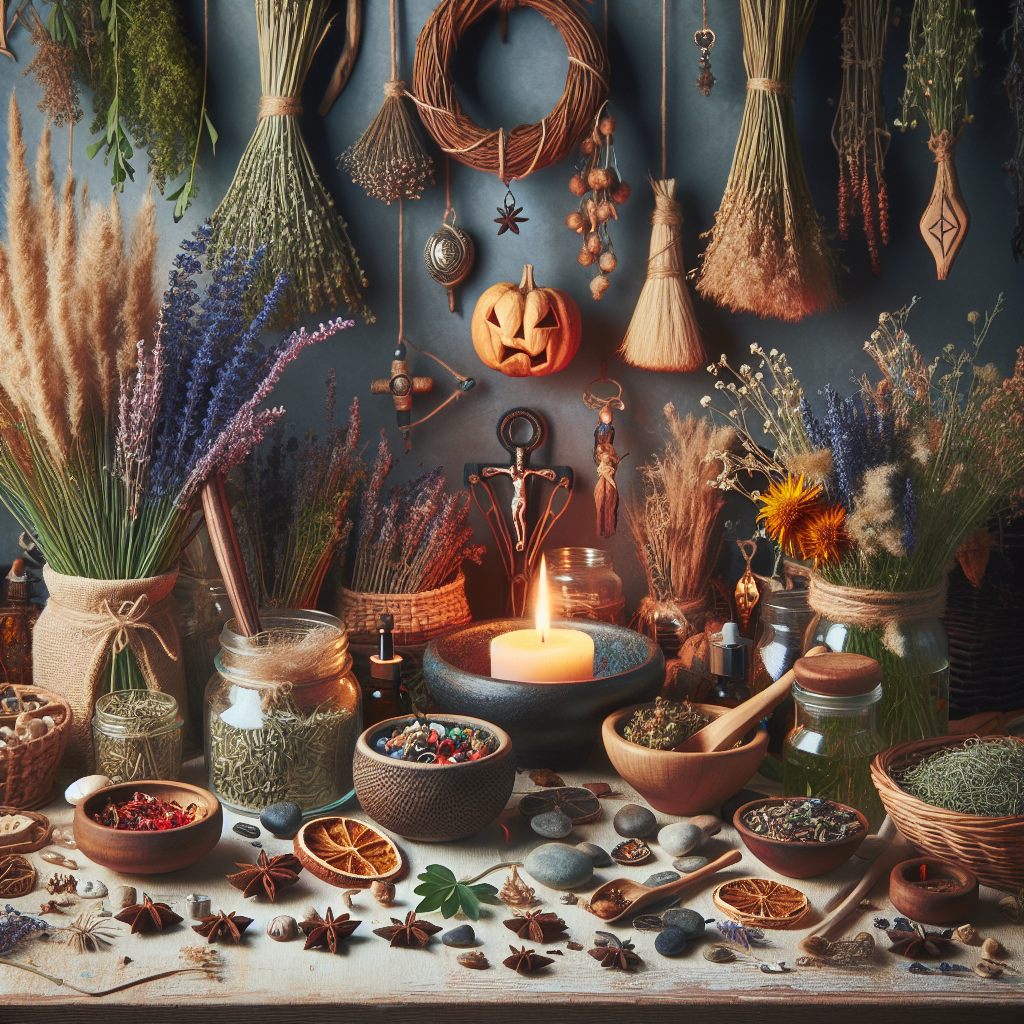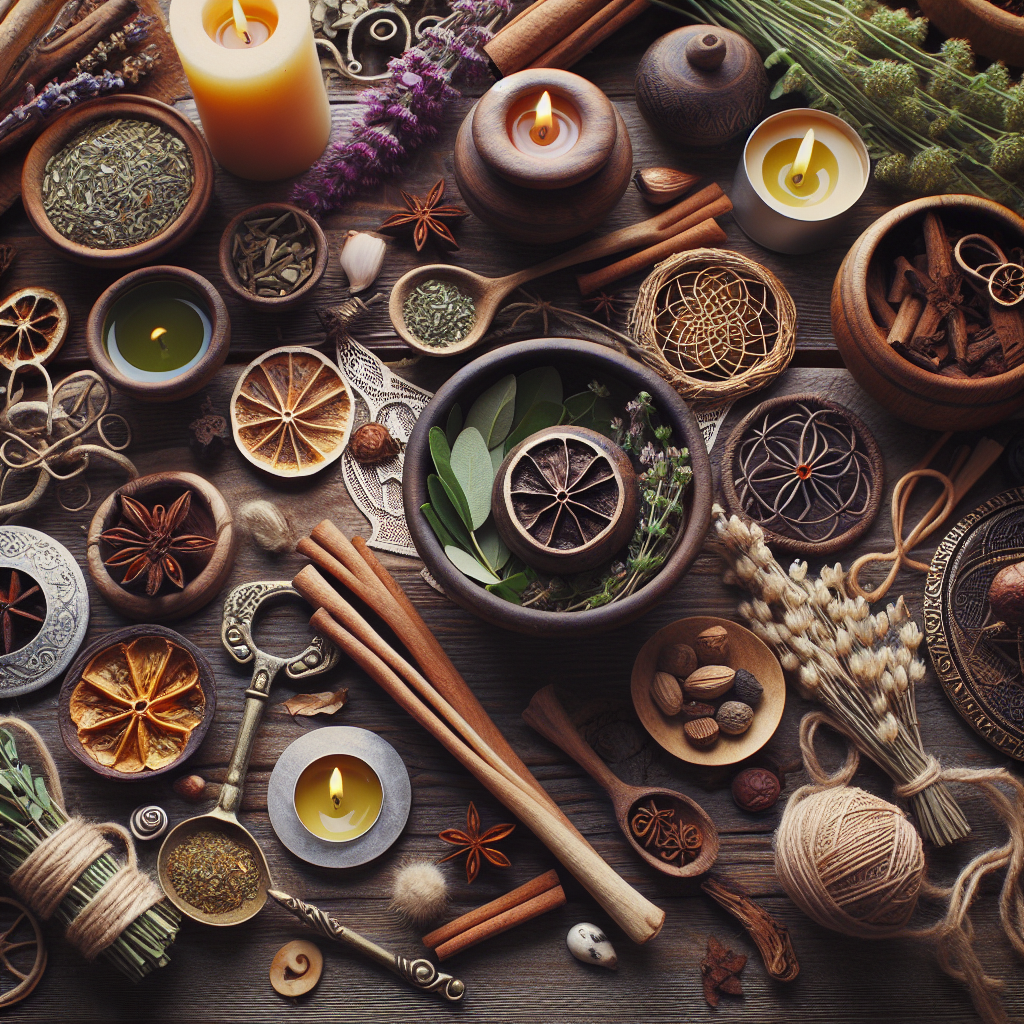As an Amazon Associate I earn from qualifying purchases.

Common herbs in Paganism and Witchcraft have been utilized for centuries, often believed to possess mystical and healing properties, making them integral components in various rituals and practices. These herbs have carved their place in both historical and modern settings, where their significance continues to flourish. Today, many individuals seek the natural benefits of these herbs, with studies indicating that over 35% of people are turning to herbal remedies for their holistic health needs.
The Origin and Evolution of Herbal Use in Pagan Practices
The use of herbs in Paganism dates back to ancient times when natural elements played a pivotal role in religious and spiritual activities. Pagans often relied on these herbs to communicate with deities, seek protection, and perform rituals that honored nature. As societies evolved, the knowledge of these herbs continued to expand, transcending into contemporary practices. Currently, many modern Pagans and witches preserve these traditional uses, integrating them into everyday life for spiritual wellness and connection with the earth.
Essential Herbs and Their Mystical Applications in Witchcraft
In Witchcraft, herbs are imbued with specific energies and associations that enhance spellwork and magickal rituals. For instance, mugwort is frequently used for its divination properties and is believed to stimulate psychic visions, while rosemary is commonly associated with protection and purification. Other herbs like lavender serve dual purposes: promoting relaxation and invoking serenity during meditative practices. The distinctive energies of each herb make them invaluable in crafting tailored rituals and spells.
Medicinal and Holistic Uses of Common Pagan and Witchcraft Herbs
Many of the herbs adored by Pagans and witches also have notable medicinal properties. Chamomile, for instance, is celebrated for its calming effects and is widely used to make tea that helps relieve anxiety and promote sleep. Similarly, peppermint is renowned for its ability to soothe digestive issues and alleviate headaches. By integrating these herbs into daily routines, individuals can reap both the magickal and health benefits they offer.
Practical Considerations and Safety in Herbal Usage
While the enchanting allure of these herbs is tempting, it is crucial to approach their use with caution and respect. Understanding proper dosages and potential interactions with other medications is vital to ensure safety. Herbs like belladonna, though historically significant, are highly toxic and require expert knowledge to handle. Utilizing these herbs responsibly not only enhances their effectiveness but also ensures the well-being of those who partake in their magickal or healing properties.
When discussing the 22 common herbs used in both Paganism and Witchcraft, it becomes clear that these sacred ingredients play a crucial role in spiritual spellcraft and natural magick. Each herb is believed to possess unique properties that aid in various rituals, spells, and healing practices. Below is an in-depth look at some of the most frequently cited Pagan herbs and witchcraft plants.
1. **Sage (Salvia officinalis):** Known for its powerful cleansing properties, sage is often burned to purify spaces and banish negative energies. It is a staple in many smudging rituals.
2. **Lavender (Lavandula spp.):** Reputed for its calming effects, lavender is used in spells for peace, tranquility, and protection. Its fragrance is known to promote restful sleep and emotional well-being.
3. **Rosemary (Rosmarinus officinalis):** An herb symbolizing remembrance and loyalty, rosemary is frequently included in rituals to enhance memory and cognitive function, as well as protection.
4. **Mugwort (Artemisia vulgaris):** Often associated with divination, mugwort is burned or used in teas to enhance psychic abilities and lucid dreaming.
5. **Basil (Ocimum basilicum):** Responded to wealth and protection spells, basil is used to attract prosperity and ward off evil. It was historically placed on doors and windows to prevent negative energies from entering.
6. **Chamomile (Matricaria chamomilla):** Known for its soothing properties, chamomile is used in spells and rituals to promote calmness, healing, and to attract love.
7. **Mint (Mentha spp.):** Used for its purifying properties, mint is believed to stimulate the mind and protect against negative influences. It is often used in prosperity and healing spells.
8. **Thyme (Thymus vulgaris):** Symbolizing courage and bravery, thyme is burned or carried to increase strength and vitality. It is also used in purification rituals and spells for health and healing.
9. **Bay Leaves (Laurus nobilis):** Employed for their wish-granting and protective properties, bay leaves are used in spells to manifest desires and provide a shield against harmful energies.
10. **Dandelion (Taraxacum officinale):** Known for divination, dandelion roots and leaves are used in teas to enhance psychic abilities. Blowing dandelion seeds is also a method of wish-making.
11. **Yarrow (Achillea millefolium):** Frequently used in love and protection spells, yarrow is known to enhance courage and protection. It is also used in divination rituals.
12. **Hyssop (Hyssopus officinalis):** Traditionally used in purification rituals, hyssop is known for its ability to cleanse and protect, purifying objects, spaces, and individuals.
13. **Patchouli (Pogostemon cablin):** With its strong, earthy aroma, patchouli is commonly used in prosperity spells and to attract love. It is also connected with fertility.
14. **St. John’s Wort (Hypericum perforatum):** Used for its healing properties, this herb is reputed to ward off evil spirits and is utilized in protection and health rituals.
15. **Nettle (Urtica dioica):** Often employed in spells for protection and exorcism, nettle is used to remove curses and send back negative energy to its source.
16. **Calendula (Calendula officinalis):** Known for its bright, sunshine-like flowers, calendula is used in spells related to healing, protection, and legal matters.
17. **Hawthorn (Crataegus monogyna):** An ancient tree believed to ward off evil, Hawthorn is used in exorcism and protection spells. It is also associated with faerie magic.
18. **Elderberry (Sambucus spp.):** Both the flowers and berries of the elderberry are used in protection and healing spells. Its connection to the Elder Mother makes it a sacred plant.
19. **Vervain (Verbena officinalis):** Traditionally used in love and protective charms, vervain is a versatile herb for purification, protection, and enhancing dream awareness.
20. **Wormwood (Artemisia absinthium):** Known for its use in banishing and protective spells, wormwood is said to repel negative spirits and energies.
21. **Rue (Ruta graveolens):** Used for protection and cleansing, rue is also believed to break hexes and curses. It is often used to guard against the evil eye.
22. **Clove (Syzygium aromaticum):** Last but not least, clove is employed in protection, exorcism, love, and money spells. Its aromatic qualities make it a favorite in various spiritual practices.
Over 64% of modern-day Pagans and practitioners of Witchcraft utilize herbs in their spiritual practices, reflecting the enduring importance of these sacred ingredients in natural magick.
Sage
One of the first herbs I ever used in rituals was sage. I remember feeling an intense calming sensation as I lit the dried leaves and the smoke filled my room. This herb is often used for smudging, a practice believed to cleanse spaces of negative energy. The process felt almost ceremonial; each corner of my room was swept with the aromatic smoke, and I could genuinely feel the shift in atmosphere.
Besides its use in cleansing, I often incorporated sage into protective charms. I would place a small bundle in my car or home, believing it would shield me from harm. Mixing sage with other herbs in a small sachet became a ritualistic practice that provided a sense of security.
Another memorable experience with sage was during a full moon ritual. I gathered with friends around a bonfire, and we each took turns saying our intentions while wafting sage smoke around the circle. It was a powerful moment of unity, and the sage seemed to amplify our energies, connecting us more deeply to each other and the earth.
Rosemary
Rosemary holds a special place in my heart because it was my grandmother's favorite herb. She always had a sprig of it in her kitchen, and its scent brings back fond memories of her cooking. When I began integrating herbs into my spiritual practice, rosemary naturally became a central element.
One practical use of rosemary has been during my meditation sessions. I sometimes place a few sprigs under my pillow or keep them nearby. The herb is said to boost memory and concentration, and I've found that its presence helps me maintain focus during meditation and dream recall sessions.
Additionally, rosemary has been a go-to herb for creating protective charms and potions. I once made a rosemary-infused oil that I use to anoint candles and talismans. This herbal oil not only smells divine but also imbues the objects with an extra layer of intent and protection.
Lavender
Lavender always brings a sense of peace and tranquility to my practices. My initial experience with lavender was through its essential oil, which I added to ritual baths to create a serene environment. The scent immediately calms my mind, making it easier to enter a meditative state.
During stressful periods, I used to keep a jar filled with dried lavender flowers on my nightstand. Taking a few deep breaths of its soothing aroma before sleep became an invaluable nightly ritual. It wasn’t just about relaxation; the lavender felt like a gentle guardian, providing emotional support during challenging times.
In spellwork, I’ve found lavender to be particularly effective for love and healing spells. Incorporating lavender into my rituals has strengthened the intentions behind my spells. Crafting a love sachet with lavender, rose petals, and a few other herbs was among the first spells where I truly felt a significant energy shift, reinforcing my belief in the power of herbal magic.
Mugwort
Encountering mugwort shifted my spiritual journey in profound ways, especially concerning my dream work and divination practices. The first time I smudged with mugwort, I felt a notable increase in my intuitive abilities. This was particularly evident during tarot readings, where insights seemed to come more freely.
I frequently used mugwort in my ritual teas, particularly before bedtime. Its association with enhancing dreams and promoting lucid dreaming made it an essential part of my nightly routine. I can vividly recall dreams that felt like genuine spiritual communications, and much of this, I attribute to mugwort.
Another powerful experience with mugwort was during a Samhain ritual. I created a mugwort incense blend that was burned while I scryed with a black mirror. The visions that night were more vivid than ever before, making mugwort a staple in my divination practices ever since.
“`html
FAQ 1: What are some common herbs used in Paganism and Witchcraft?
Common herbs used in Paganism and Witchcraft include sage, rosemary, lavender, thyme, basil, mint, chamomile, and mugwort. Each of these herbs is believed to have its own unique spiritual properties and uses in various rituals and spells.
FAQ 2: How is sage typically used in spiritual practices?
Sage, particularly white sage, is often used in smudging rituals to cleanse spaces, objects, and individuals of negative energies. It is usually bundled and burned, with the smoke being wafted around the area to promote purification and protection.
FAQ 3: What properties does rosemary have in spellcraft?
Rosemary is known for its protective qualities. It is frequently used to ward off evil spirits and to purify spaces. Additionally, it is believed to enhance memory and improve mental clarity when used in spells or rituals.
FAQ 4: Can I use kitchen herbs like basil and thyme in my spiritual practices?
Yes, many kitchen herbs such as basil and thyme have powerful spiritual properties. Basil is often associated with love, protection, and wealth, while thyme is used for health, courage, and clearing energy blockages. These herbs can be easily incorporated into everyday spiritual practices.
FAQ 5: What is mugwort commonly used for in witchcraft?
Mugwort is often used for its connection to psychic abilities and dreams. It is a popular ingredient in rituals and spells meant to enhance intuition, promote lucid dreaming, and protect against negative energy during sleep.
FAQ 6: How can lavender be used for spiritual purposes?
Lavender is widely valued for its calming and soothing properties. It is commonly used in spells and rituals to promote peace, relaxation, and emotional well-being. Lavender can be burned as incense, used in sachets, or added to baths for its calming effects.
FAQ 7: Are there any safety concerns when using herbs in witchcraft and Pagan practices?
Yes, it is important to research and know the properties and potential effects of any herb before use. Some herbs can be toxic if ingested or cause allergic reactions when applied to the skin. Always use herbs responsibly and consult reliable resources to ensure safe practice.
FAQ 8: What role do plants have in natural magick?
Plants play a significant role in natural magick due to their inherent energies and associations with different elements and deities. They are used to harness and channel these energies in rituals, spells, and various forms of spiritual work to achieve specific intentions.
FAQ 9: Is it necessary to grow my own herbs for spiritual use?
While growing your own herbs can strengthen your connection to them and the earth, it is not necessary. You can purchase herbs from reputable sources. The most important aspect is the intention and care you put into their use.
FAQ 10: How can I incorporate herbs into my daily spiritual practice?
Incorporating herbs into daily spiritual practices can be simple and varied. You can use herbal teas for meditation, add herbs to baths for cleansing, burn them as incense, or create sachets for protection and love. These small rituals can enhance your spiritual routine and bring the energies of the herbs into your everyday life.
“`

## Conclusion
The exploration of the 22 common herbs elucidates their profound significance in both Paganism and Witchcraft. These herbs, such as sage, rosemary, and lavender, serve as sacred ingredients central to various spiritual practices and rituals. They are revered not only for their practical uses in healing and protection but also for their symbolic representations and energetic vibrations. Each herb carries unique properties: sage purifies spaces, rosemary enhances memory and protection, and lavender promotes peace and calm. Through centuries of tradition, these herbs have been woven into the fabric of spiritual spellcraft and natural magick, illustrating their enduring legacy.
The detailed examination of each herb underscores their multifaceted roles in magickal practices. For instance, basil is associated with prosperity and love, while mugwort is often used for enhancing psychic abilities and dreamwork. These plants are more than mere tools; they are potent allies in one's spiritual journey, forging connections between the physical and the metaphysical. The synergistic use of these herbs amplifies intent and manifests desired outcomes, embodying the essence of natural magick. In sum, the intricate relationship between these 22 herbs and their applications in Paganism and Witchcraft illuminates the rich tapestry of sacred and spiritual traditions, emphasizing their timeless importance in nurturing both the spirit and the Earth.
Amazon and the Amazon logo are trademarks of Amazon.com, Inc, or its affiliates.


